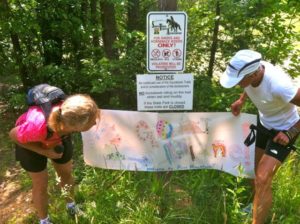
A lot of great stories emerged from Saturday’s annual meeting of the Friends of the Mountains-to-Sea Trail in Saxapahaw.
There was the story of Scott “Taba” Ward, who crossed the 950-mile Mountains-to-Sea Trail for the fourth time in 2012. This time, for variety, he did the 500-or-so miles still on paved roads on a skateboard.
There was the story of Jim Hallsey, who also did the entire trail in 2012 (there were 10 last year, 36 total have made the entire passage). Hallsey’s story was interesting for two reasons. One, he was the first person to do the eastern portion of the MST by canoe, on the Neuse River. And, Hallsey was a key figure in the trail’s formation in 1977, when he worked for the N.C. Division of Parks and Recreation.
There was the story of Jeff Brewer, who was honored for his 13 years as president of the Friends of the Mountains-to-Sea Trail, a period from the mid-1990s to the late 2000s that saw a dramatic revitalization and push to build the trail. Brewer’s story might not have been had he not been intrigued by a class offered at Louisburg College while he was attending N.C. State. It was a backpacking and hiking class that he wound up taking four times, in large part because of the instructor, a fellow by the name of Allen deHart.
And there was the story of deHart himself. Like Hallsey, deHart was there at the beginning, in 1977, and he was there in the mid-1990s when trail development was flagging. DeHart decided to jumpstart trail development by founding and personally funding the Friends of the Mountains-to-Sea Trail, then publicize its existence by becoming the first person to hike it, in 1997, then write a guidebook about the trail. (Among his many accomplishments: he’s the author of nine guidebooks, in 27 editions, on trails from Florida to West Virginia.)

Now 86, deHart remains a force in the MST. In accepting a lifetime achievement award he recalled that when the trail was officially recognized in 1977 he asked Hallsey how long he thought it might take to complete. “‘It’ll probably take four years,’ Jim replied. Jim was so ambitious.”
The trail hasn’t quite kept to that timeline — the 63 miles added last year brought the total completed to 550 miles, with about 400 to go — but the momentum of the past 15 years has continued to grow. MST Executive Director Kate Dixon told the gathering that 851 volunteers donated a total of 18,500 hours to trail development and maintenance in 2012. Thirty-seven volunteers (including deHart) were recognized for volunteering 75 hours or more. DeHart made a nod to those numbers.
“I may not be around to see the trail finished,” he said. “But when we all get to heaven, when I look around at this crowd, I can tell you, we’re going to build another.”
In that crowd of more than 200 was the Friends’ one employee, Dixon. Everyone else was one of the volunteers who are making the trail happen. Though the trail is part of the North Carolina State Parks system, it is driven almost exclusively by volunteers and donations. It is, as was evident throughout the meeting, more than a footpath from Point A (Clingman’s Dome on the Tennessee border) to Point B (Jockey’s Ridge on the coast).
“This trail is about more than going from one place to another,” one of the trail’s biggest political advocates, N.C. House Rep. Nelson Dollar from Cary, told the group. “It’s about making connections.” Human connections.
That fact wasn’t lost on one of the handful of out-of-staters in the crowd.

Last year, Colorado ultra runner Diane Van Deren was one of the 10 people to do the entire MST, and she did it faster than anyone before her: in 22 days, 5 hours and 3 minutes. It was, she has stressed almost since first setting foot on the trail last may, “not about me, but about we.”
Actually, it turns out, she realized that before even seeing the trail.
The keynote speaker for Saturday’s meeting, Van Deren had returned to tell her story and reflect on what her record-setting run had meant to her. Toward the end of her slide-show-backed presentation, a non-descript image of a hotel room appeared on the screen. Van Deren paused.
“This is our hotel room at the Pisgah Inn,” she began. “I get a little choked up when I see this.”
The photo is of a conference call that occurred a day before the ran began atop Clingman’s Dome. In the photo are Van Deren and two of her support crew chiefs, Chuck Millsaps and Amy Hamm with Great Outdoor Provision Co., which sponsored the run. The call was with 15 trail runners who would be taking turns accompanying Van Deren, who as a result of brain surgery 10 years earlier to deal with the effects of epilepsy had lost the ability to do certain things — like read a map and figure out directions.
“The runners were, like, ‘OK, I’ll take Diane on this stretch,’ and ‘No, let me have her there because I train there and it’s a little tricky in spots.’ There was all this love, with the staff, with the runners, with the volunteers.”
Part of the goal of the MST Endurance Run was to get Van Deren across the state in record time. But as Van Deren noted, the larger goal was to raise awareness and money for the trail (donations as a result of the run have exceeded the goal of $40,000). This group effort would benefit Van Deren, sure. But the long hours volunteered by so many people to make that happen would also benefit the trail.
“This is what the trail is about,” Van Deren said, motioning to the picture of a bland hotel room. “It’s not a me thing. It’s a we thing.”